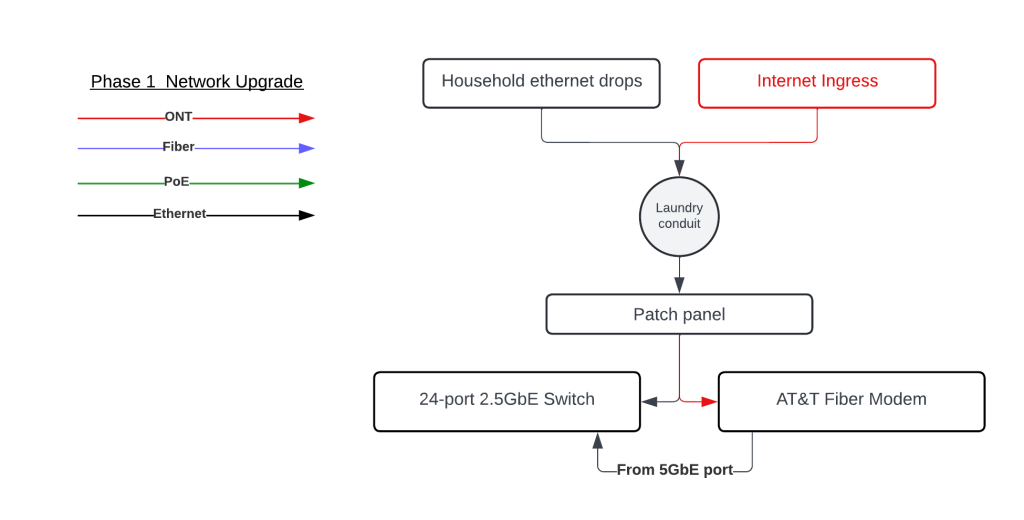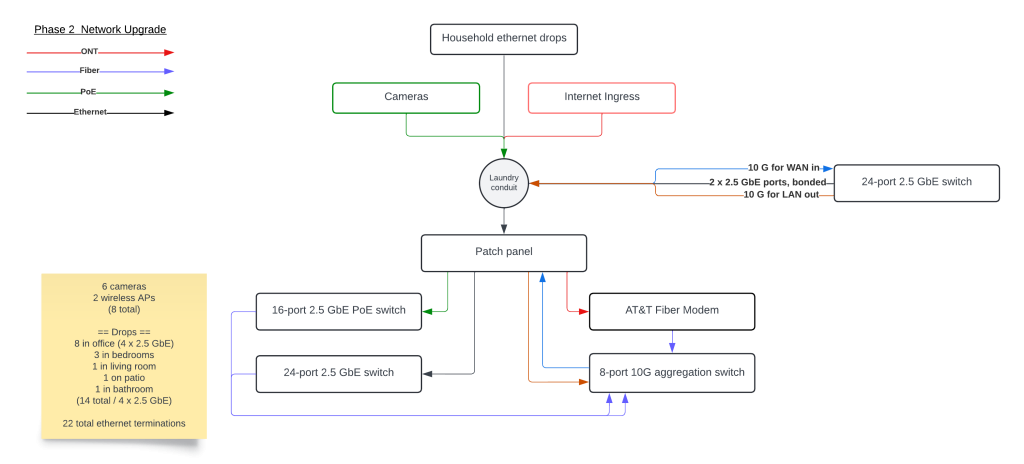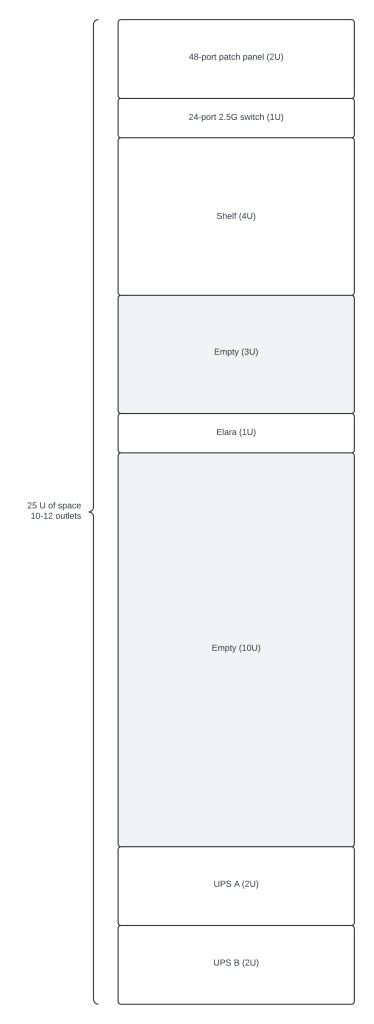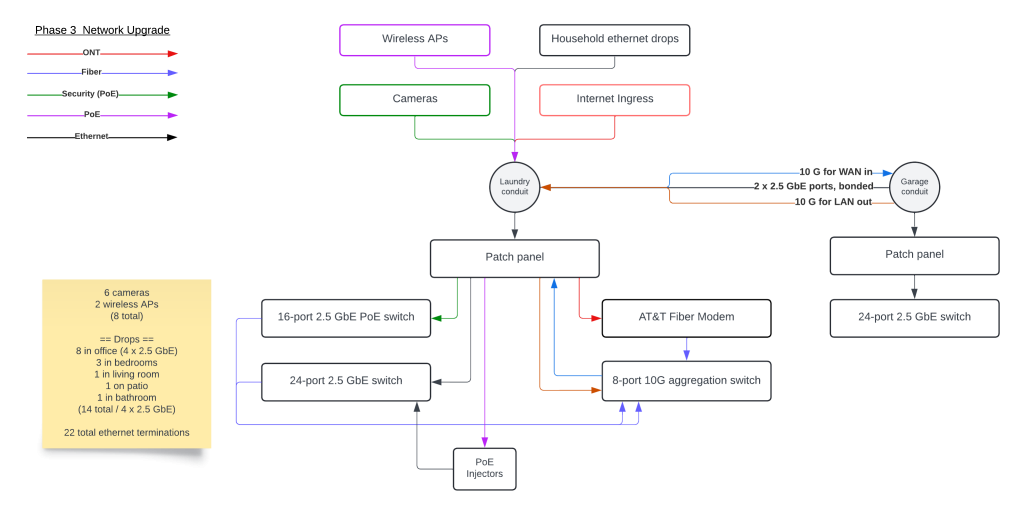I moved into my new place in the summer of 2023. Bright eyed and ready to go. Realized once I moved in that none of the ethernet ports were wired up (turned out they were actually phone jacks), so I’ve been relying on the single port in my office to provide internet to the entire house.
It’s been over a year since I moved in, so it’s high time to overhaul the entire network and make it fit me.
Objectives
There’s several objectives that need to be met with this overhaul:
- Must be easily maintainable by a future homeowner
- Every bedroom must have at least a gigabit drop
- Outside of the bedroom, every TV must have at least a gigabit drop
- Whole house wireless coverage
- Physically segregated network for security devices like cameras
- Software segregated VLANs for the household, guests, etc
- 10G ethernet or fiber connections between switches
Current Situation
My house has cat-5e ethernet wiring to three phone jacks (so we can convert those to ethernet drops) in each of the bedrooms. None of them were actually wired up. Same with coax (for cable) — although, the previous homeowners had cable TV and three different coax drops installed (poorly).
I have AT&T Fiber for internet. The fiber terminates in the garage to a fiber jack and an ethernet cable is ran to my office for connection to the modem. That is the only working ethernet drop in the entire house.
There’s a cat-6 ethernet cable running from the 5GbE port on the modem to a pair of 2.5GbE dumb switches that all of my homelab equipment is currently connected to. The rest of my devices rely on wireless from the modem.
Right now, there’s 78 wireless devices registered on the modem — mostly IoT devices — so that situation isn’t ideal and is likely saturated or close to saturation at this point since this is a consumer grade modem.
The Plan
This is going to be an expensive upgrade. I’ve budgeted out $6,000 just for the networking aspect and another $3,000 for adjacent upgrades to the house.
Ethernet Drops. I’ll be adding nine additional ethernet drops to my house. Eight in my office so there’s ample connections for anything I’d possibly need. And one in the living room, on the patio, and in the primary bathroom for TVs.
Networking Rack. Since all of the ethernet currently terminates in the laundry room, we’ll setup a wall-mounted rack to hold switches and fiber terminations.
Server Rack. For the primary networking and homelab equipment, I’ll buy a server rack and put it in the garage. Either a portable AC or mini-split will cool the rack during the summer. I’ll also have two dedicated electrical circuits installed for power.
Security. I’ll add between four and six security cameras outside powered by an independent power-over-ethernet (PoE) switch with feeds being recorded and managed by Frigate. I’ll also be replacing my current doorbell camera (which is a Vivint doorbell) with better quality hardware.
Wireless Coverage. For improved wireless coverage, I’ll go one of two ways: two indoor access points on opposite sides of the living room or one centrally located indoor access point and one outdoor access point. I think the former would provide enough coverage for inside and outside.
To ease the fiscal pain and not feel overwhelmed, I’m planning on doing this over a few phases. I’ll have a post for each of the phases as we complete them.
Phase 1
The first phase of the plan would be using the existing infrastructure to bring wired connections to the bedrooms but it would severely bottleneck the connection in the office. So all eight of the ethernet drops into the office will be added as well.
My fiber modem will be moved to a shelf in the laundry room (cutting several meters of ethernet and hopefully improving the overall speed). Since there will be eleven ethernet drops terminating, I’ll go ahead and add a 24-port 2.5GbE switch from Ubiquiti.
All of the ethernet will come through the conduit and terminate into a patch panel.
At the end of phase one, this is what the network will look like:

Spoiler: We’ve already done part of this!
The fiber modem has already been moved (but not shelved) and some of the cables have already been terminated. My roommate Zach made the cables and did the punch downs on the patch panel.
We aren’t going to talk about the cable management or precarious placement of the equipment. It will be fixed!

Phase 2
The second phase will probably be the second largest and most expensive phase of the project. I’ll be adding the network rack, running several ethernet drops, and installing some of the security devices. It’ll be a long weekend project.
The doorbell camera will be replaced and two of the outdoor cameras will be installed. (I haven’t decided yet on the devices.) While we’re in the attic, we’ll run the ethernet for the other cameras, two wireless access points, four ethernet drops, and create the conduit in the garage for Phase 3 work.
Inside, a 9U wall-mounted rack will be installed in the laundry room as the network rack. The switch will move from the shelf and leave only the modem since it will be moved to the server rack later. In total, there will be 22 ethernet terminations (assuming six cameras).
The network rack would be the only part of this setup left for the next homeowner and should be an easy-to-maintain setup. I would keep the ethernet run from the ONT into the laundry room so AT&T Fiber could be kept and the modem left in the laundry room.

In the network rack, we’ll have an 8-port 10G aggregation switch from Ubiquiti, the 24-port switch from Phase 1, a 16-port GbE PoE switch for Ubiquiti for the cameras, a 48-port patch panel, and a 700VA rack-mounted 6-outlet UPS.
The 12-port patch panel from Phase 1 will be kept and terminate those connections into the 48-port patch panel.
Pro tip: always leave some ports open in your switches so you’re not in a bind if a port dies.
In the office, I’ll have 24-port 2.5 GbE switch from Ubiquiti for the homelab equipment that will move to the server rack. Four of the drops in the office will be in use by this switch: two will be bonded for normal network access and two will terminate into the aggregation switch for the WAN ingress and LAN egress.

Phase 3
The main part of Phase 3 will be the server rack, wireless APs, and some electrical work.

The server rack will be a 25U 4-post open-frame rack on casters from StarTech in the corner of my garage.
To ensure future power demands are met, I’ll have two separate circuits added for redundancy.
Being in Alabama, the summers can get hot, so I’d add either a portable air conditioner or a mini-split for cooling the rack. The portable unit would be more economical but Technology Connections did a video showing how inefficient they are, but that may not be a concern initially since we just need forced air to cool the servers.
The server rack will house all of the homelab equipment and the modem will be moved from the laundry to here (with hopefully a direct fiber connection instead of ethernet).
The rack will be fairly empty to start with just Elara, Synology, the fiber modem, and the 24-port switch from Phase 2.
I’ll put two 8-outlet UPSes from Tripp Lite for power conditioning and battery backup. These should be sufficient for now but will likely need to be replaced later.
The rack will be adorned with LEDs and I plan on making it look more aesthetically pleasing with some wood accents inspired by Fractal North cases.
Since the drops have already been installed, the access points should be the easiest part of this phase. I’ll be putting in two U7 Pro access points from Ubiquiti. These are ceiling mounted APs that have WiFi 7 and 6GHz support. They’re enterprise grade with six spatial streams (so six antennas capable of handling large amounts of data) and up to 8 SSIDs.
Because I want to keep cameras physically segregated, I’ll be adding two 10G PoE injectors in the laundry room to power the APs.

With the completion of Phase 3, we now have a fully upgraded network!